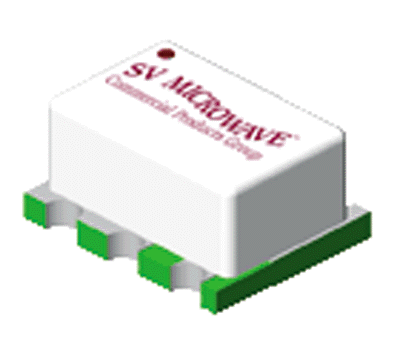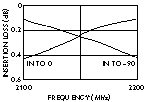BROADBAND DC TO 4 GHZ DIGITAL ATTENUATORS WITH HIGH ACCURACY

Control of signal strength while maintaining signal integrity in the transmit and receive paths of wireless systems has always been a concern of RF design engineers. A family of seven low cost two-, three- and five-bit digital attenuator (DATT) GaAs ICs has been developed to address these needs. The new attenuators offer unprecedented bandwidth from DC to 4 GHz, positive bias and control, and ±0.2 to ±0.5 dB (typ) accuracy in plastic packages as small as a six-lead SOT26 configuration. Excellent input IP3 performance of +44 to +54 dBm characterizes these attenuators, satisfying today's linearity requirements for cellular/PCS/3G/industrial, scientific and medical (ISM) and broadband datacom systems.
Table 1 lists the attenuator product line's typical characteristics. All designs were optimized for the greatest bandwidth. Product specifications are targeted toward the frequency bands of 0.7 to 1.4 GHz (cellular, personal digital cellular and personal handyphone system), 1.4 to 2.3 GHz (PCS and 3G), 2.3 to 2.7 GHz (ISM, Home RF, Bluetooth and multichannel multipoint distribution system) and 2.7 to 3.7 GHz (wireless local loop).
Exceptional DC to 4 GHz performance allows the model HMC307QS16G to address cable modem, instrumentation and all IF applications down to DC. The model HMC306MS10 DATT offers the least significant bit (LSB) step of 0.5 dB while maintaining a bit error of ±0.25 dB. Both the models HMC273MS10G and HMC307QS16G offer traditional 1 dB least significant bit steps to a maximum of 31 dB. Occupying only 14.8 mm2 in a 10-lead MSOP package, the HMC273MS10G device is the smallest five-bit, 1 to 31 dB digital attenuator available today. Reference insertion loss is typically less than 2.5 dB for each five-bit product. For base station applications, these three DATT products can help increase accuracy and reduce PCB size. They also may be cascaded for greater attenuation range.
|
TABLE I | |||||||
|
Part Number |
Description |
Frequency Range (GHz) |
Attenuation Step Sizes (dB) |
Insertion Loss (dB) |
Bit Error (dB) |
Input P3 (dBm) |
Package Area (mm2) |
|
HMC273MS10G |
five bit |
0.7 to 3.7 |
1, 2, 4, 8, 16 |
2.4 |
±0.5 |
+48 |
14.8 |
|
HMC307QS16G |
five bit |
DC to 4.0 |
1, 2, 4, 8, 16 |
2.0 |
±0.5 |
+44 |
29.4 |
|
HMC306MS10 |
five bit |
0.7 to 4.0 |
0.5, 1, 2, 4, 8 |
1.8 |
±0.25 |
+52 |
14.8 |
|
HMC230MS8 |
three bit |
0.75 to 2.0 |
4, 8, 16 |
1.8 |
±0.5 |
+46 |
14.8 |
|
HMC288MS8 |
three bit |
0.7 to 3.7 |
2, 4, 8 |
1.5 |
±0.3 |
+51 |
14.8 |
|
HMC291 |
two bit |
0.7 to 4.0 |
4, 8 |
0.9 |
±0.2 |
+54 |
9 |
|
HMC290 |
two bit |
0.7 to 4.0 |
2, 4 |
0.6 |
±0.2 |
+52 |
9 |
|
*All data are mid-band typical | |||||||

Fig. 1 The model HMC307QS16G DATT's (a) normalized attenuation, (b) bit error vs. attenuation and (c) bit error vs. frequency characteristics.
The models HMC230MS8 and HMC288MS8 three-bit DATTs bridge the gap between minimal control line requirements of three and maximum attenuation of 28 and 14 dB, respectively. The HMC230MS8 attenuator competes with several 4 to 28 dB products on the market, offering pin-for-pin compatibility. The HMC288MS8 unit steps from 2 to 14 dB with exceptional accuracy of ±0.3 dB and input IP3 of +51 dBm. The attenuator's eight-lead MSOP package requires only 14.8 mm2 of PCB area.

Fig. 2 The model HMC306MS10 DATT's (a) normalized attenuation, (b) bit error vs. attenuation and (c) bit error vs. frequency characteristics.
For circuit designers who require coarse gain adjustments, the models HMC290 and HMC291 provide two-bit control in step sizes of 4 and 8 dB to a 12 dB maximum attenuation and 2 and 4 dB to a 6 dB maximum attenuation, respectively. These products also offer minimal bit error at ±0.2 dB (typ). Input IP3 for each part is excellent at +52 to +54 dBm with less than 0.9 dB reference insertion loss. For driver amplifier and low noise amplifier gain control, handset and base station designers will find this performance a great alternative to higher loss voltage-variable attenuators. Assembled into six-lead SOT26 packages, the HMC290 and HMC291 products offer two-bit attenuator control in only 9 mm2.
Figures 1 and 2 show the DC to 4 GHz performance of the HMC307QS16G and HMC306MS10 DATTs, respectively. All of the attenuators require only a single control voltage for each attenuator bit, minimizing logic interface and package lead count. A single positive bias supplied through an external 5 kW resistor is utilized by all products except the negative-bias HMC307QS16G unit. Control and bias currents for each device are minimal at 100 to 250 mA (typ). The seven DATT ICs are manufactured using a high volume production GaAs MESFET process, resulting in a low cost family of products with consistent performance. Standard fine lead pitch plastic packaging minimizes the footprint of each part to between 9 and 29.4 mm2.
Full data sheets with the company's guarantee of electrical performance over temperature are available in its new June 2000 catalog supplement or on the Web site at www. hittite.com. The products are available immediately from stock.
Hittite Microwave Corp., Chelmsford, MA (978) 250-3343.
Circle No. 324
